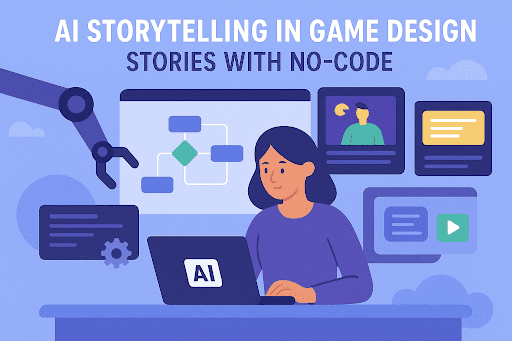For decades, game storytelling followed a familiar path. Designers wrote scripts, developers coded branching dialogue, and players experienced a narrative largely set in stone. But what if you could create a living, breathing story that reacts to every choice a player makes, all without writing a single line of code? Thanks to advancements in AI storytelling, that future is already here.
If you’ve ever had a brilliant idea for a game narrative but felt held back by your coding skills or the sheer complexity of building a dynamic story, this article is for you. We’ll explore how AI game story tools are breaking down technical barriers, empowering creators to build rich, interactive narratives with ease. Get ready to discover how you can bring your most ambitious story ideas to life.
What is AI Storytelling in Games?
AI storytelling is the use of artificial intelligence to generate and manage game elements within a game in real-time. Instead of following a rigid, pre-written script, AI-driven narratives can adapt and evolve based on a player’s actions, decisions, and even their playstyle. This creates a uniquely personal experience where the story feels like it’s unfolding just for you.
Traditional scripted narratives are like choose-your-own-adventure books. They offer a finite number of paths, each carefully planned by the developer. AI storytelling, on the other hand, is like a session of Dungeons & Dragons with a very clever Dungeon Master. The AI can improvise, creating new plot points, character interactions, and world events on the fly, ensuring no two playthroughs are ever the same.
Games like AI Dungeon and experiences in The Sims have shown glimpses of this power, where procedural storytelling generates unpredictable and often hilarious outcomes. These examples highlight a shift towards emergent narratives, where the story arises naturally from the game’s systems rather than a script.
The Magic Behind Code-Free Narratives
How do Astrocade create compelling interactive game narratives without needing a developer to code every possible outcome? The secret lies in a combination of powerful AI technologies.
- Natural Language Processing (NLP): This is the technology that allows AI to understand and respond to human language. In games, NLP can interpret player input whether typed commands or dialogue choices and generate appropriate responses from non-player characters (NPCs). This makes conversations feel more natural and less robotic.
- Machine Learning (ML): ML algorithms are the engine of adaptation. These models are trained on vast amounts of text and story data, learning the patterns of good storytelling. When a player makes a choice, the AI uses this learned knowledge to predict what should happen next, crafting a story branch that feels both logical and surprising.
- Procedural Generation: This technique allows AI to create content algorithmically. In AI storytelling, it can be used for everything from generating new quests and character backstories to creating unique items and descriptions based on the current state of the game world.
Together, these technologies create a system where the narrative can respond dynamically to player agency, making the world feel truly alive.
Popular AI Game Story Tools
The world of no-code game development is expanding rapidly, with several AI story tools designed to help creators build interactive narratives. These tools generally fall into three main categories.
1. AI Writing Assistants
These tools are designed to help you brainstorm, write, and refine your game’s script. They are perfect for overcoming writer’s block and generating a wealth of content quickly.
- Features: AI writing assistants can generate character profiles, plot outlines, dialogue, and descriptive text based on simple prompts.
- Best Use Cases: Ideal for solo developers or small teams who need to produce large amounts of written content without hiring a dedicated writer. Tools like Jasper or Sudowrite can help flesh out your world with rich lore and engaging character backstories.
2. Interactive Narrative Platforms
These platforms provide visual, node-based editors that let you map out complex branching storylines without touching any code. They are the digital equivalent of a writer’s storyboard.
- Features: Tools like Twine, Inkle, and Articy: Draft 3 offer intuitive drag-and-drop interfaces for creating branching dialogues and tracking story variables. Many now integrate AI to help suggest new branches or dialogue options.
- Best Use Cases: Perfect for narrative-heavy games like visual novels, RPGs, and adventure games. They give you a high level of control over the story’s structure while simplifying the technical implementation.
3. Procedural Story Generators
These are the most advanced AI storytelling tools, capable of generating entire narrative arcs dynamically based on a set of rules and player actions.
- Features: These systems manage the high-level story progression, creating quests, events, and character relationships in real-time. Think of them as AI “story managers.”
- Best Use Cases: Excellent for open-world games and sims where you want the world to feel like it’s living and changing independently of the player’s direct actions. They excel at creating endless replayability.
Benefits of AI-Powered Storytelling
Integrating AI into your narrative design process offers a host of advantages, especially for indie developers.
- Increased Player Engagement: Personalization is a powerful tool. When a story reacts to a player’s choices, it creates a deeper sense of immersion and ownership over the narrative.
- Reduced Development Time and Costs: AI tools can automate many of the tedious aspects of narrative design, like writing item descriptions or simple NPC dialogue, freeing you up to focus on the big picture. This is a game-changer for creators with limited time and resources.
- Enhanced Replayability: With dynamic storytelling, players can experience a different narrative each time they play, which significantly increases the value and longevity of your game.
- Accessibility for Non-Technical Creators: This is perhaps the biggest benefit. AI storytelling tools are democratizing game development, allowing writers, artists, and designers to build the games of their dreams without needing to become expert programmers.
Getting Started: Your First AI-Powered Narrative
Here’s a simple guide to creating your first AI-driven story.
- Choose Your Tool: Start with something user-friendly. An interactive narrative AI Gaming platform like Astrocade is a great entry point. It’s free, easy to learn, and has a large community for support.
- Outline Your Core Idea: Before you start, have a basic concept for your story. Who is the protagonist? What is their goal? What is the central conflict? You don’t need every detail, just a starting point.
- Create Your First Branches: In your chosen tool, start by writing your opening scene. Then, present the player with a choice. For each choice, create a new “node” or passage that describes the outcome. Use an AI writing assistant if you need help brainstorming different consequences.
- Introduce a Variable: To make things more dynamic, add a simple variable. For example, create a “trust” score for an NPC. Certain dialogue choices could increase or decrease this score, unlocking different story paths later on.
- Test and Iterate: Play through your story constantly. Does it flow well? Are the choices meaningful? Use feedback to refine your narrative, add more branches, and make the experience more engaging.
The Future of Interactive Narratives
We are only at the beginning of the AI storytelling revolution. In the near future, we can expect to see AI integrate even more deeply with other game systems. Imagine NPCs who remember your past actions and change their behavior accordingly, or worlds that evolve procedurally based on the collective actions of all players.
Of course, challenges remain. Ensuring that AI-generated content maintains a high level of quality and coherence is a key hurdle. But as the technology matures, these issues will be solved, paving the way for a new golden age of interactive storytelling.
Start Your AI Gaming Story Today
AI storytelling tools are no longer a far-off futuristic concept; they are accessible, powerful, and ready for you to use right now. They offer an incredible opportunity to create the kind of dynamic, player-driven narratives that were once the exclusive domain of big-budget studios.
Don’t let a lack of coding skills or resources hold you back. Explore the tools mentioned in this article, start experimenting, and discover just how easy it is to bring your unique story to life. Your next great adventure is waiting to be written.



































